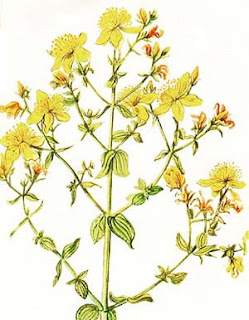 |
| St. John's wort ( Hypericum perforatum ) |
 |
| St. John's wort ( Hypericum perforatum ) |
The original homeland of her is Europe (Asia Minor and Greece) and Siberia. Ubiquitous in all subtropical and temperate zones. Once used to exorcise evil spirits and dealing with the consequences of snake bites. According to traditional belief because the reddish oil juice (such as blood), which occurs when the plant broke, so they were curing skin diseases because the skin is also bleeding. While this is still frivolous, there are scientific confirmation in treating bruises, burns and other wounds. Requires regular watering and soil moisture. It grows everywhere. The plant has a peculiar odor, pungent, bitter and aromatic flavor. It is used for decoration and for the medicine: to decorate the slopes of ramps, the beams, the edges of the leaves so characteristic interspersed with numerous translucent dots (glands filled with essential oil) so they look finely drilled and hence the name of the plant - perforatum. Leaves are arranged oppositely, ovoid - blunt, smooth stems with lots of translucent spots on the rim with black spots. Well developed golden flowers with 5 petals, bottom also have black spots, forming bloom. Rubbing flowers emit blood-red juice. Petals are 3-4 times longer than the calyx and asymmetric. The plant blooms the entire summer and medicinal parts are located on the upper half of the plants in bloom. The root is not intended to cure. Therefore, the plant can not and should not start pulling out of the country.
 |
| St. John's wort ( Hypericum perforatum ) |
 |
| St. John's wort ( Hypericum perforatum ) |